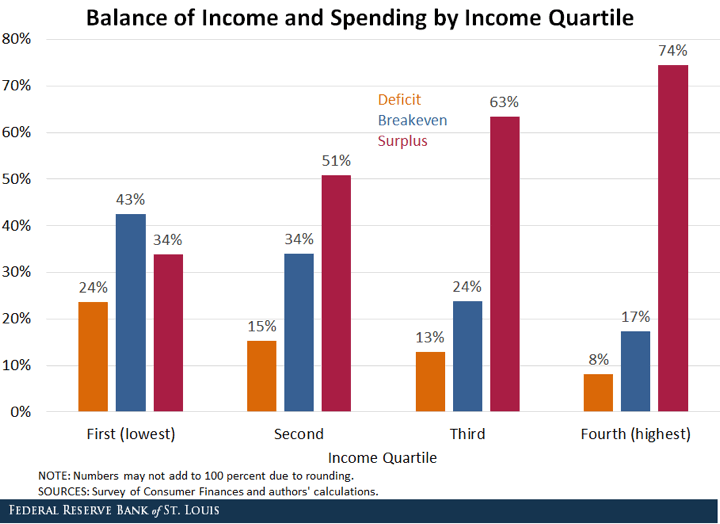 In the post How Well Do Americans Balance Income and Spending? by the St. Louis Fed, they examine the breakdown of household spending as compared to income.
In the post How Well Do Americans Balance Income and Spending? by the St. Louis Fed, they examine the breakdown of household spending as compared to income.
In terms of the big picture, 55% of US households were net savers (earned more than they spent), 30% broke even, and 15% ran an income deficit (earned less than they spent). However, that’s everyone across all income levels, and thanksfully they looked deeper in the 2016 Survey of Consumer Finances and broke it down further by income quartile.

It is not surprising that lower income households overall have a harder time spending less than they earn. Instead, I would consider these two observations:
Out of the households in the bottom income quartile earning less than $27,000 per year, roughly 75% of them manage to break even and/or save money each year. This is not to say that households that are earning close to the poverty line ($26k for a family of four) are not struggling. However, I think a family that is “just getting by” on a $100,000 income would appreciate their situation more if they know that so many $26k income families are breaking even at this level, with a third of them even managing a surplus.
Out of the households in the top income quartile earning over $98,000 per year, roughly 25% manage to save nothing or go into debt at the end of each year. Yes, most households with a six-figure income are saving some money. But a quarter of them aren’t saving anything!
I have always been struck by the huge variation in spending by the same number of humans in the same city. The family earning $50,000 finds a way to spend $50,000. The family earning $250,000 finds a way to spend $250,000. If you have a relatively high income, that is a huge opportunity. Don’t waste it. If you create a budget surplus and invest it in productive assets, one day those assets will do the “work” to make money instead of you.
 The Best Credit Card Bonus Offers – 2025
The Best Credit Card Bonus Offers – 2025 Big List of Free Stocks from Brokerage Apps
Big List of Free Stocks from Brokerage Apps Best Interest Rates on Cash - 2025
Best Interest Rates on Cash - 2025 Free Credit Scores x 3 + Free Credit Monitoring
Free Credit Scores x 3 + Free Credit Monitoring Best No Fee 0% APR Balance Transfer Offers
Best No Fee 0% APR Balance Transfer Offers Little-Known Cellular Data Plans That Can Save Big Money
Little-Known Cellular Data Plans That Can Save Big Money How To Haggle Your Cable or Direct TV Bill
How To Haggle Your Cable or Direct TV Bill Big List of Free Consumer Data Reports (Credit, Rent, Work)
Big List of Free Consumer Data Reports (Credit, Rent, Work)
That’s OK. I’m sure once socialism takes hold, we’ll all be paying more taxes to pay off everyone else’s debts. I’m losing my job at the end of this week. To be honest, I’m starting to wonder why I’m even searching for a new one. Whatever isn’t taken by force through taxes is eaten away by inflation and lower wages.
A lot of these analyses get distorted by people in retirement spending down assets, often making the “poor” seem worse off than they are. Were they careful to remove those people or otherwise appropriately take them into account?
” If you have a relatively high income, that is a huge opportunity. Don’t waste it.” Although it is my approach, I can also understand that some people view life differently and enjoy the money they have by spending it. If that makes them happy, be it! It should be respected.
The bottom line of this graph is that the higher the income, the more likely people will save. Nothing too surprising in my opinion.
I would challenge the notion that imprudence should be respected.
One takeaway I found interesting was that across all four quartiles, the percent of households operating at a deficit was roughly half the percent of the households at the breakeven point. I suppose that illustrates the point that regardless of income, there will always be some who spend more than their income, and some who will manage to spend it all. Still, that ratio holding true across the board surprised me.
I don’t understand the jump in surplus in the 4th qtr…I mean with Christmas, and all of the spending that is taking place how is it that there is also a surplus??
It’s by income quartile, not calendar quarter. The 4th income quartile would be the people in the top 25% of income.